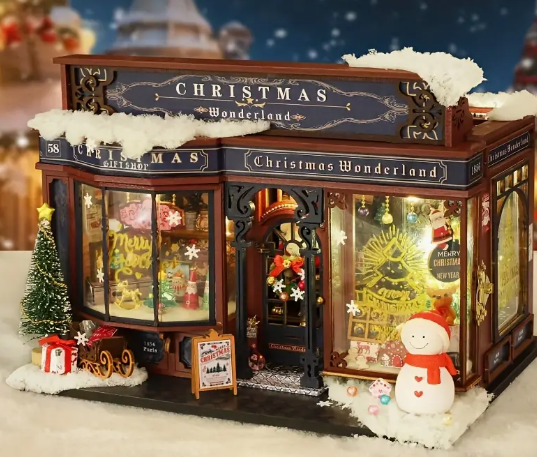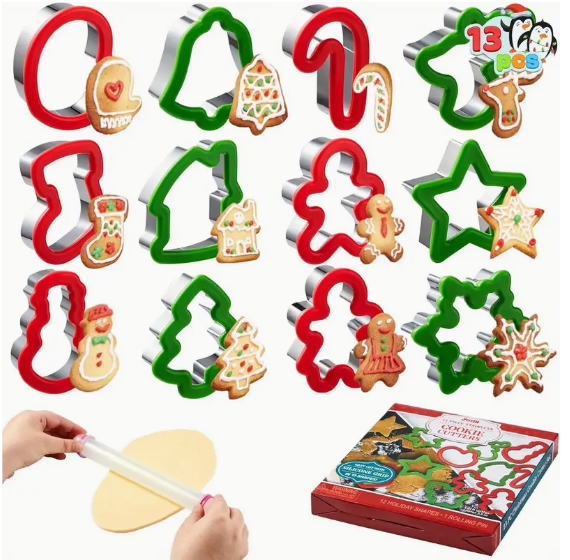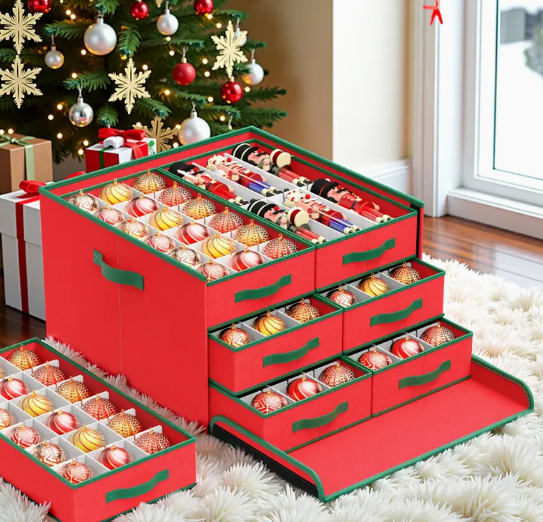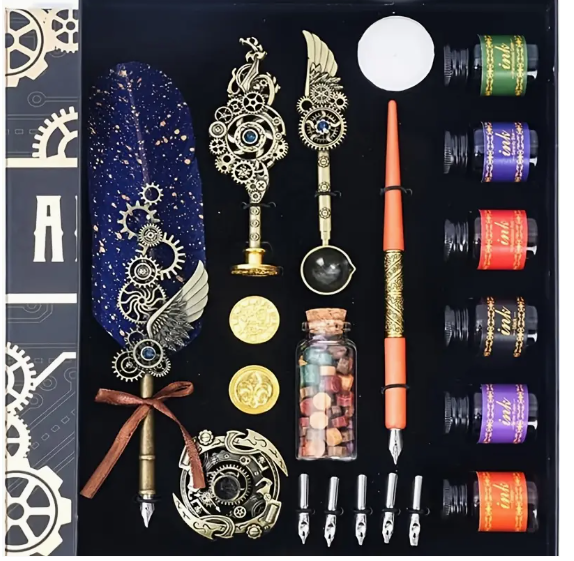When it comes to e-commerce, no season compares to Christmas. It’s the time of year when shoppers are not only buying for themselves but also filling carts with gifts for family, friends, coworkers, and even pets. In 2024, US holiday retail sales exceeded $960 billion, and nearly a third of that came from online purchases. With more buyers shifting to digital platforms every year, 2025 is shaping up to be an even bigger opportunity for online sellers.
For dropshippers, Christmas offers a unique advantage: shoppers are actively searching for festive décor, cozy winter essentials, and thoughtful gift items. That means demand is high, and customers are often buying multiple products at once, which naturally boosts average order value. Unlike evergreen sales, the holiday season brings a sense of urgency—buyers want products now, before the celebrations begin.
This guide highlights 25+ Christmas dropshipping products for 2025 that capture the holiday spirit while offering solid profit potential. Whether you’re just starting out or looking to scale an established store, these products, paired with the right sourcing strategy, can help you turn the busiest shopping season into your most profitable quarter yet.
The Growth of Christmas E-Commerce in the US and Worldwide
Christmas has always been the most important shopping season, but in recent years, the growth of e-commerce has completely reshaped how consumers celebrate and spend. In the US alone, holiday retail sales reached more than $960 billion in 2024, with nearly 30% of purchases made online. This share is expected to rise again in 2025 as consumers increasingly prefer the convenience, variety, and delivery speed of online shopping.
Globally, the trend is just as strong. Holiday e-commerce spending is projected to surpass $1.2 trillion in 2025, driven by markets in North America, Europe, and Asia-Pacific. Countries like the U.K., Germany, and Canada show similar patterns to the US, with a growing portion of consumers choosing online stores over traditional retail.
Social media has also become a critical driver of holiday shopping habits. Platforms like TikTok, Instagram, and Pinterest inspire millions of gift ideas and décor trends each year. Viral content can turn a niche product—whether it’s a unique Christmas ornament, a cozy gift set, or a trending gadget—into a bestseller almost overnight.
For dropshippers, this growth means two things:
-
Bigger demand than ever before, spread across multiple categories like décor, apparel, toys, and tech gifts.
-
Stronger competition is making it essential to prepare early, source efficiently, and market creatively.
In short, the rise of Christmas e-commerce in the US and worldwide creates a massive opportunity. Sellers who understand these trends and align their product catalog with holiday demand can position themselves for record-breaking sales in Q4 2025.
What Makes a Winning Christmas Product in 2025?
Not every festive item will turn into a bestseller. In a crowded holiday market, the products that stand out are those that balance seasonal excitement with practical qualities that shoppers actually need. A winning Christmas product in 2025 usually shares several traits:
1. Strong Emotional Connection
Christmas is built on emotion—joy, nostalgia, and family traditions. Products that tap into these feelings, like personalized ornaments or cozy blankets, resonate more deeply with buyers. Surveys show that over 60% of consumers choose holiday gifts based on sentimental value, not just utility.
2. Gift-Ready Appeal
Shoppers are time-poor in December. Items that look ready to gift—whether through attractive packaging, customization, or bundled sets—have an edge. Products priced in the $20–$80 range often perform best, since they feel affordable yet meaningful.
3. Seasonal Utility
Beyond décor, consumers love items that add value to gatherings: festive kitchenware, baking tools, or family game sets. These are products that not only symbolize Christmas but also make the holiday experience smoother and more enjoyable.
4. Visual & Social Media Impact
Christmas products that photograph well or make great short-form videos gain traction on TikTok, Instagram, and Pinterest. Think glowing LED decorations, themed fashion, or viral gadgets that become part of online gift guides.
5. Reliable Fulfillment
Timing is everything in Q4. Products that are lightweight, compact, and stocked in local warehouses reduce delivery risks. In fact, shipping speed is a top decision factor for nearly 50% of US holiday shoppers—so items that can reliably arrive before Christmas Eve are far more likely to convert.
6. Balance of Evergreen and Seasonal Value
The smartest sellers mix seasonal hits like ornaments and party décor with evergreen gifts such as tech gadgets, jewelry, and wellness products that stay relevant beyond December. This ensures steady sales even after the holiday rush.
In short, winning Christmas products in 2025 are not only festive but also emotional, practical, and fulfillment-friendly. Dropshippers who filter products through these criteria are better positioned to capture the holiday spirit—and the sales that come with it.
25+ Christmas Dropshipping Products in 2025
1. Christmas Tree Ornaments & LED Lights

Why It Sells: Decorating the tree is a tradition in almost every household.
Trend Factor: LED lights and personalized ornaments are among the top-selling holiday products each year.
Profit Potential: Lightweight, low-cost, with strong upsell potential in bundles.
Store Strategy Tip: Offer ornament sets and tree-lighting kits as gift-ready packages.
2. Inflatable Outdoor Decorations

Why It Sells: Families love showcasing large Santas, snowmen, and reindeer in their yards.
Trend Factor: Oversized décor went viral on TikTok in 2024, and demand is rising again.
Profit Potential: Higher-ticket items ($80–$200), fewer sales but strong margins.
Store Strategy Tip: Market as “neighborhood showstoppers” for homeowners.
3. Cozy Winter Blankets & Throws

Why It Sells: The colder months boost demand for comfort products.
Trend Factor: Weighted and heated blankets are experiencing steady growth in Q4.
Profit Potential: Mid-ticket ($40–$100), strong seasonal sales.
Store Strategy Tip: Position as both personal comfort items and thoughtful gifts.
4. Seasonal Fashion Accessories (Scarves, Gloves, Beanies)

Why It Sells: Affordable gifts that appeal across age groups.
Trend Factor: “Winter outfits” consistently trend on Pinterest and Instagram in November–December.
Profit Potential: Low sourcing cost with 50–70% markups.
Store Strategy Tip: Sell as bundled “Winter Essentials Sets.”
5. Smart Watches & Fitness Trackers

Why It Sells: Popular tech gifts, often tied to New Year’s health goals.
Trend Factor: The US wearables market surpassed 85 million users in 2025.
Profit Potential: Mid- to high-ticket with strong ROI.
Store Strategy Tip: Promote as “Christmas gifts to kick-start 2026 resolutions.”
6. Kids’ Educational Toys

Why It Sells: Parents prefer toys that blend entertainment with learning.
Trend Factor: STEM toys and interactive kits continue to grow in popularity.
Profit Potential: $20–$50 price point with high sales volume.
Store Strategy Tip: Target parents and grandparents with gift bundles.
7. Pet Christmas Outfits & Stockings

Why It Sells: Pet owners enjoy including pets in holiday traditions.
Trend Factor: Americans spent over $2 billion on pet products during Christmas 2024.
Profit Potential: Lightweight, fun, and highly shareable on social media.
Store Strategy Tip: Encourage UGC campaigns with “share your pet’s Christmas look.”
8. Personalized Jewelry & Accessories

Why It Sells: Emotional, thoughtful gifts always perform well.
Trend Factor: Personalized necklaces, bracelets, and rings see sales spikes every holiday season.
Profit Potential: High perceived value with strong markups.
Store Strategy Tip: Offer engraving, initials, or birthstone customizations.
9. DIY Christmas Craft Kits

Why It Sells: Families love crafting together during the holiday season.
Trend Factor: DIY kits surged in popularity post-pandemic and remain strong.
Profit Potential: $20–$40 range, easy to upsell with décor or baking tools.
Store Strategy Tip: Position kits as “fun for family nights.”
10. Festive Kitchenware & Baking Tools

Why It Sells: Holiday baking is a tradition in many households.
Trend Factor: Cookie cutters, molds, and holiday aprons rank high on Amazon in December.
Profit Potential: Lightweight and easy to bundle, with 200%+ markups possible.
Store Strategy Tip: Sell as “holiday baking essentials” kits.
11. Aromatherapy & Self-Care Gift Sets

Why It Sells: Wellness products make thoughtful and practical gifts.
Trend Factor: Wellness gifting is expected to grow by 12% in 2025.
Profit Potential: Mid-ticket ($30–$60) with strong branding potential.
Store Strategy Tip: Emphasize relaxation and stress relief for the holiday season.
12. Eco-Friendly Storage Solutions

Why It Sells: Families declutter after Christmas and prepare for the New Year.
Trend Factor: Eco-conscious living continues to drive consumer choices.
Profit Potential: Steady demand, strong margins with eco-materials.
Store Strategy Tip: Market as “holiday clean-up essentials.”
13. Holiday Scented Candles

Why It Sells: Scents like cinnamon, pine, and vanilla instantly create a festive atmosphere.
Trend Factor: The US candle market exceeds $3 billion annually, with holiday scents peaking in December.
Profit Potential: Lightweight, low-cost, strong markup potential.
Store Strategy Tip: Bundle candles with décor or self-care gift sets.
14. Board Games & Family Games

Why It Sells: Families spend more time indoors and enjoy games during gatherings.
Trend Factor: Holiday board game sales spike each December as gifts and entertainment.
Profit Potential: $20–$60 range with high repeat demand.
Store Strategy Tip: Promote as “family bonding gifts.”
15. Christmas Stockings

Why It Sells: A classic tradition for kids and families.
Trend Factor: Personalized stockings continue to trend on Etsy and Amazon.
Profit Potential: Low cost with customization opportunities for premium pricing.
Store Strategy Tip: Offer embroidery or name-tag add-ons.
16. Luxury Pens & Stationery Sets

Why It Sells: Popular as corporate and professional gifts.
Trend Factor: Stationery gifts maintain steady seasonal demand.
Profit Potential: Mid-range ($30–$80) with premium branding opportunities.
Store Strategy Tip: Target professionals and students with gift-ready packaging.
17. Holiday Pajamas & Matching Family Sets

Why It Sells: Cozy pajamas are both practical and festive, often bought for whole families.
Trend Factor: Matching sets trended heavily on TikTok and Instagram in 2024.
Profit Potential: High order value when sold as family bundles.
Store Strategy Tip: Market with family-oriented visuals and UGC.
18. Mini Projectors

Why It Sells: Perfect for family movie nights during the holidays.
Trend Factor: Portable projectors are gaining traction as affordable home entertainment.
Profit Potential: Mid-ticket ($80–$150) with $40+ margins.
Store Strategy Tip: Position as “holiday gift + family entertainment.”
19. Christmas-Themed Apparel (Sweaters, Hoodies, Socks)

Why It Sells: Ugly sweaters and festive socks are a fun, affordable way to celebrate.
Trend Factor: Ugly Christmas sweaters trend every year across social media.
Profit Potential: Lightweight, high-volume category.
Store Strategy Tip: Use POD (print-on-demand) for unique designs.
20. Personalized Photo Frames & Keepsakes

Why It Sells: Sentimental gifts that capture family memories.
Trend Factor: Custom keepsakes are among the most gifted items during Christmas.
Profit Potential: Strong markups thanks to personalization.
Store Strategy Tip: Market as meaningful “memory gifts” with engraving options.
21. Skincare & Beauty Gift Sets

Why It Sells: Beauty products are a go-to category for holiday gifting.
Trend Factor: Beauty e-commerce continues double-digit growth, especially in Q4.
Profit Potential: $30–$70 with strong branding opportunities.
Store Strategy Tip: Emphasize festive packaging and limited-edition sets.
22. Travel Accessories (Neck Pillows, Luggage Organizers)

Why It Sells: Many families travel during the holidays, boosting demand for travel-friendly gear.
Trend Factor: US holiday travel volume increases every December.
Profit Potential: Mid-ticket items ($20–$50), compact and practical.
Store Strategy Tip: Promote as “holiday travel essentials.”
23. Festive Tableware & Dining Sets

Why It Sells: Christmas gatherings call for themed plates, cups, and table décor.
Trend Factor: Holiday tableware consistently trends on Pinterest.
Profit Potential: Easy to upsell in bundles for large gatherings.
Store Strategy Tip: Market as “holiday hosting essentials.”
24. Eco-Friendly Gift Wrap & Packaging

Why It Sells: Sustainability is becoming part of gift-giving traditions.
Trend Factor: Over 60% of US consumers prefer eco-conscious options.
Profit Potential: Low cost, highly scalable product.
Store Strategy Tip: Position as “green Christmas gift wrapping.”
25. Portable Coffee Makers & Mugs

Why It Sells: Warm beverages are part of winter comfort and gifting.
Trend Factor: Travel mugs and mini coffee machines trend each holiday season.
Profit Potential: Mid-ticket ($40–$100), high gifting appeal.
Store Strategy Tip: Bundle mugs with coffee or tea gift sets.
26. Luxury Scarves & Gloves

Why It Sells: Stylish yet practical holiday gifts.
Trend Factor: Winter accessories spike in demand every December.
Profit Potential: Strong margins with premium materials (wool, cashmere).
Store Strategy Tip: Target gift buyers looking for affordable luxury.
Where to Source Christmas Dropshipping Products Reliably
The Christmas season creates both massive opportunity and massive pressure. Shoppers want unique products at good prices, but most importantly, they want items delivered on time—well before December 25. That makes supplier choice one of the most critical decisions for dropshippers in Q4.
1. Global Wholesale Marketplaces
Large marketplaces like Alibaba and Global Sources offer extensive catalogs of Christmas décor, toys, and gifts. They’re useful for product discovery, but longer shipping times and minimum order requirements can be a challenge when working with the short holiday timeline.
2. Local Wholesalers and Distributors
Sourcing from US or European distributors provides faster delivery and easier returns, which is essential during the peak shopping season. However, prices are usually higher, and the selection may be narrower compared to global marketplaces.
3. Dedicated Dropshipping Platforms
For most sellers, the most flexible option is to use a dropshipping platform that combines product sourcing, fulfillment, and logistics in one place. CJdropshipping is one strong choice for the holiday season: it offers a broad product catalog that covers Christmas essentials—like décor, toys, fashion accessories, and gift sets—while also providing US and European warehouse options to reduce delivery times. With automatic fulfillment and custom packaging services, sellers can scale their stores quickly while still presenting products in a way that feels premium and gift-ready.
4. Hybrid Strategies
Some sellers mix approaches—using dropshipping platforms to test products and then bulk-stocking proven winners in local warehouses for faster turnaround. This reduces risk while making sure bestsellers remain in stock through the holiday rush.
In short, sourcing Christmas dropshipping products reliably comes down to balancing variety, speed, and quality. Sellers who plan ahead and partner with dependable suppliers are far more likely to capture the holiday demand and keep customers satisfied during the busiest shopping season of the year.
Tips for Selling Christmas Products Successfully Online
The Christmas shopping season moves fast, and competition is fierce. With millions of buyers turning to online stores for gifts and décor, execution matters just as much as product selection. Here are some strategies to help you maximize sales during Christmas 2025:
1. Launch Early Campaigns
Many shoppers start gift-hunting in November, while last-minute buyers flood in during December. Listing products early allows you to capture both groups. Use email marketing and social media teasers to build anticipation before peak demand hits.
2. Use Gift-Ready Bundles
Shoppers are drawn to convenience. Instead of selling single products, create curated sets—like a “Holiday Baking Kit” or “Winter Essentials Gift Pack.” Bundling raises average order value and makes your store more appealing to time-pressed buyers.
3. Lean Into Visual Storytelling
Christmas is about emotion and atmosphere. Use high-quality photos and short-form videos to show how your products fit into holiday moments—cozy nights, family gatherings, or gift exchanges. TikTok, Instagram Reels, and Pinterest are especially powerful during Q4.
4. Highlight Urgency and Deadlines
With a fixed calendar, urgency is a powerful motivator. Use countdown timers, limited-stock notifications, and clear shipping cut-off dates like “Order by Dec 18 for Christmas Delivery” to push hesitant buyers to act quickly.
5. Optimize for Mobile Shoppers
Over 70% of holiday e-commerce purchases in the US are made on mobile devices. Ensure your store loads fast, product pages are easy to navigate, and checkout is seamless on smartphones.
6. Deliver Excellent Service
Christmas buyers expect quick responses and smooth returns. A positive experience can turn seasonal customers into year-round repeat buyers, especially if you plan to carry evergreen products after December.
How to Choose Christmas Products to Dropship (Profit, Shipping & Safety)
Choosing Christmas products to dropship requires balancing seasonality, margins, logistics, and legal/safety compliance. First, identify niches that reliably spike during the holiday window: seasonal décor (ornaments, LED lighting), gifting categories (personalized goods, stocking stuffers), party supplies (tableware, photo-booth props), and convenience/experience items (gift wrap kits, advent calendars). Prioritize SKUs that sell well at low return risk — small, giftable items tend to perform better than bulky furniture during holiday peaks.
Profitability: calculate a conservative landed cost per unit (product price + packaging + dimensional shipping + payment fees + any platform/fulfillment fees). Holiday paid-traffic costs often rise, so aim for a minimum gross margin of 35–50% to cover customer acquisition, discounts, and returns. Use bundles (gift set, seasonal + core product) to raise average order value (AOV) without raising CAC disproportionally.
Shipping strategy is critical. During November–December, carriers fill up and transit times extend. Favor suppliers with local or regional warehouses in key markets (US, UK, EU, AU) to guarantee 3–7 day delivery for last-minute shoppers. Offer express shipping as a premium option and clearly display delivery cutoffs. For direct-from-China sourcing, present expected transit windows (e.g., 10–20 days) and use order cutoffs in product listings to avoid negative experiences.
Inventory and fulfillment: because dropshipping often means suppliers hold stock, verify supplier stock cadence and ask about holiday-specific surge capacities. Negotiate lead-time SLAs for high-value SKUs and request pre-holiday buffer stock if feasible. For POD or personalized items, set conservative production timelines and promote ordering early.
Safety and compliance: holiday items often include lights, batteries, or small parts—these trigger product safety standards (e.g., UL, CE, RoHS, small-parts choking warnings for kids). Verify supplier testing documentation, include clear age warnings, and never sell uncertified electrical goods. For personalized items, ensure intellectual property and trademark checks to avoid takedowns.
Customer experience: invest in accurate product pages with holiday visuals, clear size/spec dimensions, and unambiguous shipping cutoffs. Include gift-friendly options (gift wrap, fast gift messaging). Proactively set expectations with “order by” banners and automated pre-shipment notifications. Plan a simple, fast return policy for holiday items to reduce support friction.
Promotion tactics: use urgency (limited stock badges, cutoffs), bundles, and free-shipping thresholds to increase order size. Test Facebook/Instagram creatives that show gifts in context. Consider retargeting last-click carts with expedited shipping offers close to cutoff dates.
Finally, monitor KPIs hourly during peak days: fulfillment time, cancellations, refund rate, and negative feedback. For holiday success, the winning formula is conservative logistics planning, rigorous supplier vetting for safety and capacity, and pricing that absorbs higher acquisition costs while still protecting margins.
Which Products Are Best for Which Platform (Shopify vs Amazon vs eBay vs TikTok Shop)
Choosing which products to sell on a specific platform is as much about audience intent and discovery mechanics as it is about product characteristics. Each marketplace rewards different value propositions—understanding those will improve conversion, reduce returns, and boost ROI.
1.Shopify (DTC, brand-first): Best for differentiated products, private-label goods, and bundles where branding matters. Shopify customers arrive on your site via paid ads, organic search, or influencer traffic, so you control product pages, UX, A/B testing, and post-purchase flows. Ideal products: higher-margin lifestyle items, subscriptions, customizable gifts, and niche home décor. Use Shopify when you need full control over pricing, retention (email flows), and margin capture. Heavy emphasis on compelling content, on-site SEO, and email/retention playbooks.
2.Amazon (intent-driven, high conversion): Optimal for commodity items, fast-moving consumer goods, and products where Prime-level shipping matters. Amazon buyers are often purchase-ready and trust fulfillment speed. Best products include household essentials, repeat-purchase consumables, branded toys, and electronics accessories that meet Amazon’s FBA size/weight economics. Keep margins tight but volume high. Focus on great listing optimization, strong reviews, and competitive Buy Box pricing. Consider FBA for Prime eligibility and better conversion.
3.eBay (price discovery, auctions, used/unique): Suited to collectibles, refurbished items, overstock, and time-limited deals. eBay’s audience tolerates variability in condition and often seeks bargains. Products that perform: vintage furniture, refurbishable decor, clearance lots, and one-off items. Use eBay for liquidation, testing price elasticity, or moving unusual SKUs that don’t justify full ecommerce infrastructure.
4.TikTok Shop (discovery, impulse-driven, creative): Best for visually engaging, low-to-mid priced products with strong demonstrable benefit—beauty gadgets, trending apparel, compact electronics, and novelty giftables. TikTok’s algorithm surfaces content to broad audiences; the key is short-form, high-energy demos that show instant value. Conversion often relies on live-selling and creator partnerships. Shipping speed helps but creative virality drives demand. Use TikTok Shop for trend-hopping SKUs and impulse buys; monitor churn since trends can be ephemeral.
5.Cross-platform strategies: match product logistics to platform economics. Bulky, high-weight items (furniture, large home goods) typically perform better via Shopify (where shipping costs are visible and customers expect lead times) or Wayfair/Amazon’s specialized programs—not TikTok impulse channels. Small, low-cost, giftable items fit TikTok, Amazon, and eBay well. For private-label brands, prioritize Shopify for long-term LTV and Amazon for volume and discovery.
6.Testing and flows: validate across one channel first—test creatives, price points, and shipping promises. Use channel-specific optimizations: ad creatives for Shopify, A+ content and reviews for Amazon, auction or fixed-list strategies for eBay, and creator-driven videos for TikTok Shop. Always account for fees and fulfillment differences in pricing models.
7.In short: pick Shopify for brand and control, Amazon for high-intent scale, eBay for liquidation/unique items, and TikTok Shop for trend-driven, impulse-friendly SKUs. Match product size, price elasticity, and logistics complexity to the platform’s strengths.
Sourcing & Supplier Tips for Christmas Holiday Inventory
Holiday sourcing requires more lead time, tighter vetting, and contingency planning than standard supply cycles. The Christmas season concentrates demand into a narrow window, compounding the impact of supplier failures. Follow a disciplined approach to sourcing holiday inventory that emphasizes capacity, compliance, and predictable lead times.
Start early and plan buffer stock. Order earlier than normal—ideally 6–12 weeks prior for international suppliers and 3–6 weeks for domestic options—depending on the SKU. Seasonal spikes amplify production lead times and carrier congestion; having a buffer reduces stockouts during critical sale periods.
Diversify suppliers and warehouses. Avoid single-source dependency for best-selling holiday SKUs. Maintain at least one domestic or regional backup supplier/warehouse for each hero product. If using dropshipping partners, prefer those with US/EU fulfillment options to guarantee shorter transit for last-minute buyers.
Negotiate holiday SLAs and contractual terms. Get written agreement (email is a start) on lead times, stock thresholds, packing/labeling standards, and expedited options. For private-label or branded sets, secure committed production slots. Clarify who is liable for late shipments and define remediation steps—discounts, refunds, or alternate fulfillment.
Audit quality and compliance aggressively. Holiday products often include electrical components, candles, toys, and small parts—each with distinct safety standards (flame retardancy, battery safety, small-parts regulations). Request certificates of conformity, lab test reports, and perform random QC during production. For POD or personalized items, pre-approve final proofs and require a pre-shipment photo or short video.
Plan packaging and kitting. Holiday purchases often require gift-ready packaging. Work with suppliers to offer gift wrapping, bundles, and double-boxing for fragile items. Standardize carton dimensions to optimize freight and avoid dimensional-weight surprises. For bundled SKUs, pre-kit at the supplier warehouse if possible to reduce downstream handling and returns.
Map returns and reverse logistics. Heavy holiday returns can crush margins. Choose suppliers that accept returns to a regional warehouse or offer prepaid returns. Consider offering limited-time “gift return” policies and explicit return windows to manage expectations.
Communicate lead times clearly on product pages. Use countdowns and “order by” banners for delivery cutoffs. Automate shipping updates and provide customer support templates for delays. During the pre-Christmas rush, increase customer service staffing or outsource overflow to an experienced partner.
Test high-volume fulfillment before the season. Run a stress test with a simulated spike (e.g., 3–5x baseline orders) with your supplier to verify capacity and communications. If using third-party logistics (3PL), ensure they can scale pick/pack operations quickly.
Have a contingency shipping plan. Identify alternate carriers and express lanes; consider pre-paying for blocks of air freight or express shipments for high-margin top sellers. Reserve expedited fulfillment bandwidth for VIP orders or top SKUs.
Final Thoughts: Turning Christmas Trends into Year-End Profits
Christmas isn’t just another seasonal sales spike—it’s the defining moment of the year for most e-commerce sellers. With billions spent on gifts, décor, and festive essentials, this is the time when the right product mix and smart execution can transform a store’s revenue curve.
The beauty of dropshipping during Christmas is the flexibility it gives you. You can quickly test trending products—like ornaments, cozy blankets, or tech gadgets—while scaling proven winners that fit into broader niches. Pairing festive items with evergreen categories ensures that your momentum doesn’t stop on December 25 but continues into the New Year.
Success in 2025 will come down to preparation and reliability. Sellers who source from dependable partners, market creatively, and deliver on time will not only capture Christmas sales but also build trust that lasts long after the holiday season. Christmas can be the launchpad for Q4 growth—and for those who plan well, it can also set the stage for sustained success in 2026.
